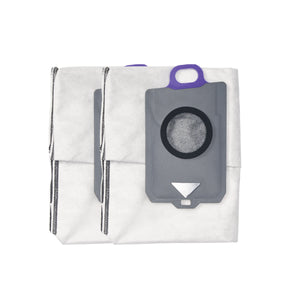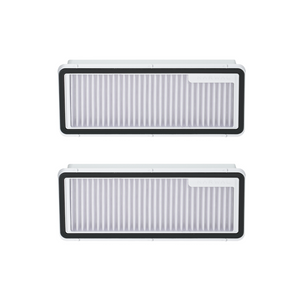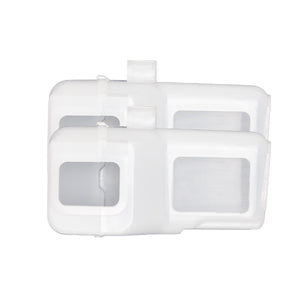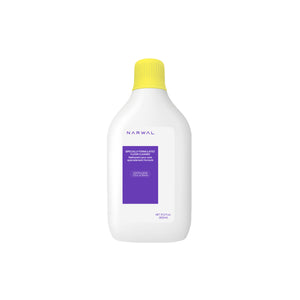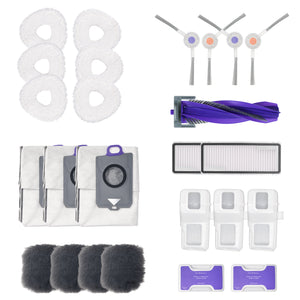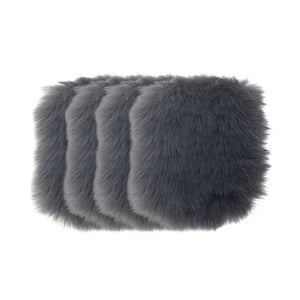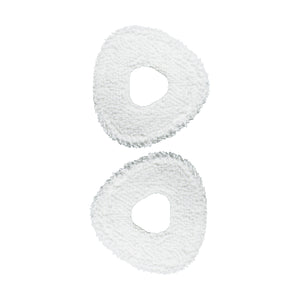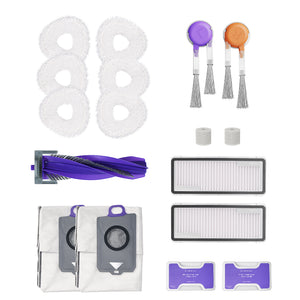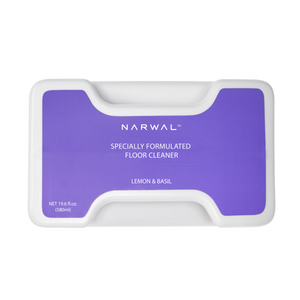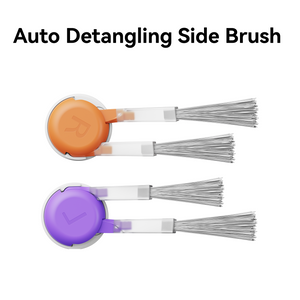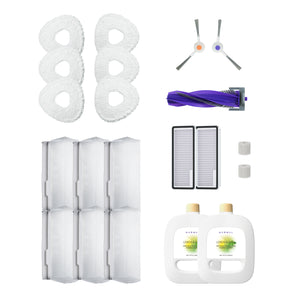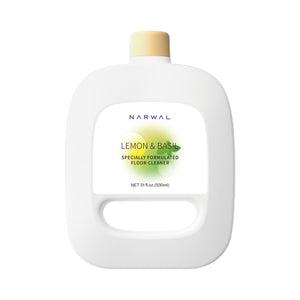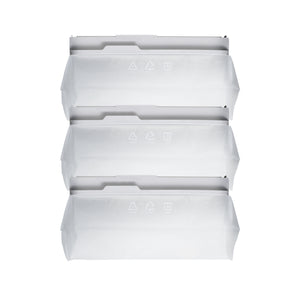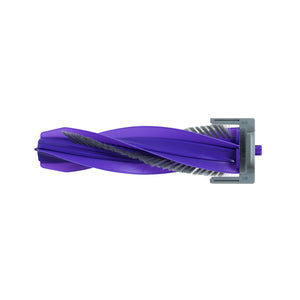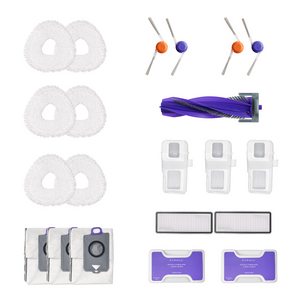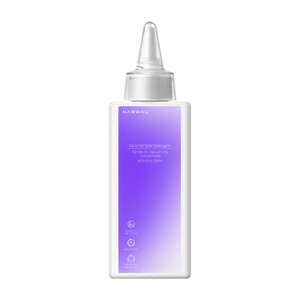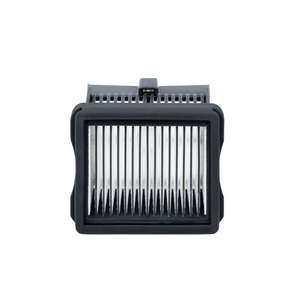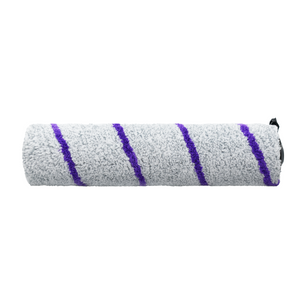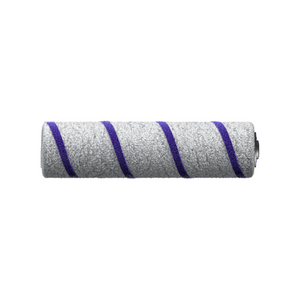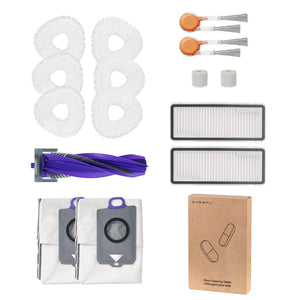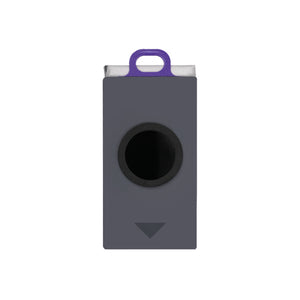If you're tired of finding long strands of hair on your floors, even after vacuuming, a robot vacuum designed for human hair can make a difference. But not all models are built to handle the challenge.
This guide explains whether robot vacuums are truly effective for human hair and highlights the top performers in 2026. You will also learn how to choose the right features for homes where hair sheds often. At the end, we share simple maintenance tips and practical answers to common questions about cleaning long hair.
Why Robot Vacuums Struggle With Long & Human Hair
Robot vacuums are designed to handle dust and crumbs easily — but long and human hair pose a completely different challenge. Hair behaves like thread: it wraps, tangles, and sticks to brushes, filters, and wheels.
Here’s why most robot vacuums struggle with hair:
Hair Wraps Around Brushes
Long strands of human or pet hair twist around the main roller brush. Over time, this restricts movement, reduces suction, and can even damage the motor if not cleaned regularly.
Static Cling on Hard Floors
Human hair often clings to tiles and hardwood due to static electricity. This makes it harder for low-suction vacuums to pick up every strand — especially in corners or under furniture.
Clogged Filters and Air Paths
Fine hair fragments can block the filter or suction channel, reducing overall cleaning efficiency and airflow. Without proper maintenance, this leads to overheating or performance loss.
Human Hair vs. Pet Hair Cleaning Challenge
Pet fur is generally shorter and lighter, while human hair is longer and more elastic. Human hair tends to coil tightly around brushes, while pet fur mostly spreads widely across floors. That’s why a vacuum that handles pet fur easily may still struggle with human hair.
Pro Tip: Always look for anti-tangle rubber brushes, auto-cleaning systems, or self-detangling rollers — features that Narwal vacuums like the Freo Z Ultra and Z10 use to solve these exact problems.
Are Robot Vacuums Good for Human Hair?
Yes, but only specific models.
Many robot vacuums struggle with human hair because it wraps around the brush and reduces suction. However, models with strong suction and anti-tangle brush designs can clean long hair effectively without constant maintenance. Modern robot vacuums like Narwal Freo Z Ultra are also effective for long hair and pet hair, thanks to their self-detangling design.
If the vacuum uses rubber rollers, tangle-free brushes, or has a self-cleaning system, it can pick up hair without clogging. These features are essential for removing hair from hard floors or carpets efficiently.

Best Robot Vacuums for Long & Human Hair in 2026
Whether it’s long hair from family members or pet fur embedded in carpets, finding the right robot vacuum can make all the difference. The best robot vacuums for long and human hair in 2026 combine strong suction, tangle-free brush designs, and smart self-cleaning systems to keep your floors spotless with minimal effort.
Before diving into the detailed Narwal product breakdown, here’s a quick look at this year’s top-performing robot vacuums for handling long, human, and pet hair. These picks were chosen based on suction power, anti-tangle technology, navigation precision, and maintenance convenience.
Top 5 Robot Vacuums for Long & Human Hair (2026 Editor’s Picks)
|
Model |
Best For |
Suction Power |
Anti-Tangle Design |
Price Range |
|
Narwal Freo Z Ultra |
Thick or long hair, precision cleaning |
12,000 Pa |
Certified tangle-free brush |
$$$$ |
|
Narwal Freo Z10 |
Heavy shedding homes, multi-surface |
15,000 Pa |
DualFlow anti-wrap system |
$$$$ |
|
Narwal Freo Pro |
Smart maintenance & all-in-one cleaning |
8,500 Pa |
Self-detangling DualFlow |
$$$ |
|
Roborock S8 Pro Ultra |
Pet hair & carpet deep cleaning |
6,000 Pa |
Rubber roller brushes |
$$$ |
|
iRobot Roomba j9+ |
Auto-emptying & smart mapping |
5,000 Pa |
Dual multi-surface brushes |
$$$ |
Editor’s Note: While several brands offer impressive anti-tangle features, Narwal’s Freo series leads the 2026 lineup with its AI DirtSense 2.0, self-detangling design, and fully self-cleaning base station, providing a genuine hands-free solution for managing long, human, and pet hair.
Narwal Freo Z10 — Best for Heavy Shedding Homes
-
15,000 Pa Suction: Lifts over 99 % of hair and debris from hard floors and carpets.
-
Tangle-Free Brushes: DualFlow system prevents hair wrapping.
-
Smart Dirt Detection: Adjusts suction to clean hair and stains automatically.
-
Precise Navigation: LiDAR 4.0 maps your home accurately, avoiding obstacles and cables.
The Freo Z10 features a fully self-maintaining base station that automatically washes mops with hot water, dries them at 104 °F, compresses dust, and stores debris for up to 120 days. Its MopExtend and EdgeSwing systems reach corners and toe-kicks, while real-time particle sensing optimizes cleaning pressure on the spot.
[cta:narwal-freo-z10-robot-vacuum-mop]
Narwal Freo Z Ultra — Best for Thick or Long Hair
-
12,000 Pa Suction: Clears 99 % of hair and dust from all surfaces.
-
Certified Tangle-Free: SGS-tested main brush avoids hair wrapping.
-
DirtSense 2.0: Adjusts suction or mopping mode based on mess type.
-
Dual Cameras + AI Chips: Detect and avoid obstacles with precision.
The Freo Z Ultra specializes in tackling stubborn, thick hair and sticky debris that other vacuums often miss. Its dual scrubbing mops apply consistent pressure to lift hair trapped along edges and baseboards. With real-time dirt sensing, it switches between suction and mopping modes to avoid spreading hair and dust.
The base station handles mop washing, drying, and detergent dispensing automatically.
A 2.5 L compressed-dust bag reduces manual maintenance dramatically.
[cta:narwal-freo-z-ultra-robot-vacuum-mop]
Narwal Freo Pro — Best for Smart Maintenance
-
8,500 Pa Suction: Captures hair and dust from hard floors and carpets alike.
-
Tangle-Free System: DualFlow design with self-detangling brushes.
-
AI DirtSense: No spot left uncleaned thanks to smart sensors.
-
Smart Navigation: LiDAR 4.0 and 3D structured light avoid clutter precisely.
Designed for busy homes, the Freo Pro goes beyond routine vacuuming with its all-in-one base station that washes, dries, and self-cleans automatically. Its dual triangular mops scrub at 180 RPM with 2.65 lbs of pressure to remove sticky hair clumps and stains. With auto dust compression and 7-week debris storage, you’ll rarely need to empty it manually.
[cta:narwal-freo-pro-robot-vacuum-mop]

How to Choose the Best Robot Vacuum for Hair (Human, Long, or Pet)
Finding the best robot vacuum for human, long, or pet hair isn’t just about power — it’s about the right combination of suction, design, and maintenance.
Hair is one of the toughest messes to manage: it wraps, sticks, and clogs.
Below, we break down the essential features that help you choose a robot vacuum that doesn’t get hair stuck and keeps your floors clean with minimal effort.
Prioritize Strong Suction Power
For long or thick hair, models with at least 3,000 Pa suction are recommended.
Suction strength determines how well a vacuum can lift strands from carpets and floor crevices. Hair often settles deep into fibers, so weaker vacuums tend to leave strands behind or push them around.
Modern models like the Narwal Freo Z Ultra and Z10 adjust suction automatically depending on surface type — increasing power when encountering carpeted areas or heavy shedding. If possible, choose a vacuum that offers variable suction for long hair, balancing performance and battery life efficiently.
Look for an Anti-Tangle Brush Design
One of the biggest challenges with hair is tangling around the main brush. Choose a vacuum that uses rubber or silicone rollers instead of traditional bristles — these resist hair wrap more effectively. Look for features such as:
-
Self-detangling rollers that spin in alternating directions to loosen caught hair
-
V-shaped side brushes or flexible arms that sweep along edges and corners
-
Detachable brush covers for quick cleaning and maintenance
An anti-tangle brush not only keeps your vacuum efficient but also extends its lifespan and saves you hours of manual cleaning.
Choose a Large Dustbin or Auto-Empty Base
Hair, especially long strands, takes up space fast. For everyday use, pick a robot vacuum with at least a 400 ml dustbin capacity. If you want a low-maintenance solution, consider models with an auto-empty base station that can hold debris for several weeks at a time.
This feature compresses dust and hair automatically, so you don’t need to empty the bin after every cleaning session — perfect for households with long-haired family members or multiple pets. The Narwal Freo Z10, for example, can store up to 120 days of compressed debris, combining convenience with consistent suction power.
Check Navigation and Mapping Accuracy
No matter how strong the suction, poor navigation leaves hair behind. Look for robot vacuums with LiDAR, 3D structured light, or AI camera navigation — these systems map your rooms precisely and avoid obstacles like cords or furniture legs.
Accurate mapping ensures the vacuum doesn’t skip or repeat zones and reaches hidden areas (like under sofas or beds) where hair tends to gather. If you have a large or multi-floor home, multi-map memory is another useful feature to ensure complete, efficient coverage.
Consider Noise and Cleaning Comfort
Robot vacuums with strong suction or rotating brushes can be noisy, especially on hard floors. If you often run your vacuum during work hours or at night, look for models rated below 60 dB or with a built-in Quiet Mode.
Keep in mind that auto-empty bases can produce a brief burst of noise when transferring debris — this is normal and usually lasts less than 15 seconds. Choosing a quieter, well-insulated model improves comfort, especially in small apartments or shared spaces.
Pro Tip: Match the Features to Your Home Type
-
For long human hair → prioritize suction and anti-tangle brushes.
-
For pet hair → choose an auto-empty base and wide roller design.
-
For mixed flooring → look for adjustable suction and smart mapping.
The ideal robot vacuum for hair — whether human, long, or pet — combines strong suction, an anti-tangle brush, and a self-emptying system. These three features ensure smooth performance, minimal maintenance, and a truly hair-free home.

Maintenance Tips to Handle Hair Build-Up (Including Long and Pet Hair)
Keeping your robot vacuum in top condition is essential when dealing with human, long, or pet hair. Without regular care, tangled hair can clog brushes, reduce suction, and shorten the machine’s lifespan. Follow these anti-tangle maintenance tips to keep your robot vacuum performing like new:
Remove Hair from Brushes Regularly
Hair — especially long strands — easily wraps around the main roller brush and side brushes. Check these parts at least once a week. Use the included cleaning tool or a small cutter to remove trapped strands, especially around the brush bearings, where hair tends to accumulate the most. For models like Narwal Freo, this process is easier thanks to detachable brush covers and a self-detangling roller system.
Inspect the Suction Path and Intake
Even if the brushes are clean, hair build-up can block the vacuum’s suction path, especially near the intake. Inspect this area regularly and clear any obstructions to maintain consistent suction for long hair and avoid overheating. A clean airway ensures steady airflow and extends motor life.
Clean or Replace Filters Consistently
Fine hair fragments can clog HEPA or foam filters, reducing suction and air quality. Wash reusable filters with water as directed and let them dry completely before reinserting. For non-washable filters, replace them every 1–3 months depending on usage and hair density. This step is crucial for households with pets that shed or family members with long hair.
Empty the Dustbin or Auto-Empty Base Frequently
Even large dustbins fill up quickly when cleaning hair. Empty the bin after every cleaning cycle — or rely on an auto-empty base, which automatically transfers hair and dust into a sealed bag. Replace the dust bag every 4–7 weeks or as indicated by your app. Regular emptying prevents loss of suction and helps your vacuum handle long and pet hair more efficiently.
Wipe Sensors and Cameras
Hair and dust can stick to sensors or camera lenses, affecting navigation accuracy. Use a soft, dry microfiber cloth to gently clean these components every two weeks. Proper maintenance ensures precise mapping and obstacle avoidance, especially in homes where pet hair and fine dust are common.
Keep Software and Firmware Up to Date
Robot vacuums with smart mapping rely on software to optimize cleaning routes and detect hair build-up. Manufacturers like Narwal often release updates that improve hair detection algorithms, anti-tangle logic, and performance efficiency. Use the companion app to check for firmware updates regularly — it’s one of the simplest ways to keep your vacuum running at its best.
Pro Tip: Prevent Hair Build-Up Before It Starts
-
Run your robot vacuum on a daily or scheduled basis to prevent excessive accumulation.
-
Use the auto-cleaning station after every session if available.
-
For heavy hair-shedding homes, clean the brushes twice per week for optimal results.
Summary: Regular upkeep is the key to preventing robot vacuum hair build-up, especially when dealing with long and pet hair. By following these steps, you’ll extend your vacuum’s life, maintain consistent suction power, and enjoy a truly hair-free home.
Is a Robot Vacuum Worth Buying for Long Hair?
Yes, a robot vacuum is worth buying if long hair is a constant problem in your home.
It helps keep floors hair-free with minimal effort, making them a smart investment for households with long-haired residents or family members who shed a lot.
How Do Robot Vacuums Clean Long Hair?
Robot vacuums clean long hair by using strong suction and tangle-resistant brushes that pull hair directly into the dustbin.
Some models go further with floating roller brushes, side brushes that shift angles, and sensors that detect hair-covered areas. These features help reduce clogging and prevent the hair from wrapping around internal parts.
How to Remove Human Hair from Carpet Without a Vacuum?
You can remove hair from carpets using a rubber broom, a lint roller, or a damp rubber glove.
These tools create friction that lifts hair from the carpet fibers. For larger areas, brushing in one direction helps gather hair into clumps that are easy to pick up. This method works well for quick cleanups when a vacuum is not available.
Can A Robot Vacuum Handle Pet And Human Hair Together?
Absolutely — many high-end models are built for both pet fur and human hair. The key is to look for a vacuum with a self-detangling roller, auto-empty base, and at least 3,000 Pa suction. These features ensure smooth pickup across carpets and hard floors without clogging. The Narwal Freo Z10, for instance, can manage heavy shedding homes efficiently.
What’s The Best Robot Vacuum For Women’s Hair?
Longer hair tends to shed more and wrap easily around brush rollers. For this type of hair, choose a vacuum with an anti-tangle system and rubber brushes instead of bristles. The Narwal Freo Pro is an excellent choice for women’s hair cleaning, combining high suction and self-cleaning maintenance for minimal upkeep.
How To Prevent Robot Vacuum Brush From Tangling?
To prevent tangling, clean your vacuum’s main brush weekly and check for hair wrapping around the roller bearings. Using a vacuum with anti-tangle technology — such as flexible rubber rollers or self-detangling designs — can drastically reduce hair entanglement. Running shorter, frequent cleaning sessions also helps minimize buildup.
How Often Should I Clean My Robot Vacuum If I Have Long Hair?
For households with long hair or pets, clean your vacuum brushes and filters at least once a week, and empty the dustbin after every use. If your vacuum has an auto-empty base, replace the dust bag every 4–6 weeks. Regular cleaning helps maintain suction power and prevents blockages that reduce performance.
Is It Safe For Robot Vacuums To Clean Pet Fur Daily?
Yes — in fact, daily operation is ideal. Frequent cleaning prevents pet fur and hair from tangling around brushes or clogging filters. Smart models like Narwal’s Freo series can be scheduled to clean automatically while adjusting suction levels for different surfaces.

Say Goodbye to Long Hair Mess With the Best Robot Vacuums
Keeping your home free of human hair doesn’t have to be a constant chore. With the right robot vacuum, maintenance becomes less about daily effort and more about smart, automated care.
But not every model is built for the job. As robot vacuums continue to evolve, features like tangle-resistant rollers, high-pressure suction, and precision cleaning have become essential, not extras.
Narwal has positioned itself at the forefront of this shift, bringing solutions that align with real cleaning challenges like long hair, tight corners, and busy routines. If hair buildup is disrupting your space, it may be time to consider smarter tools, ones designed not just to clean but to think ahead for you.





















